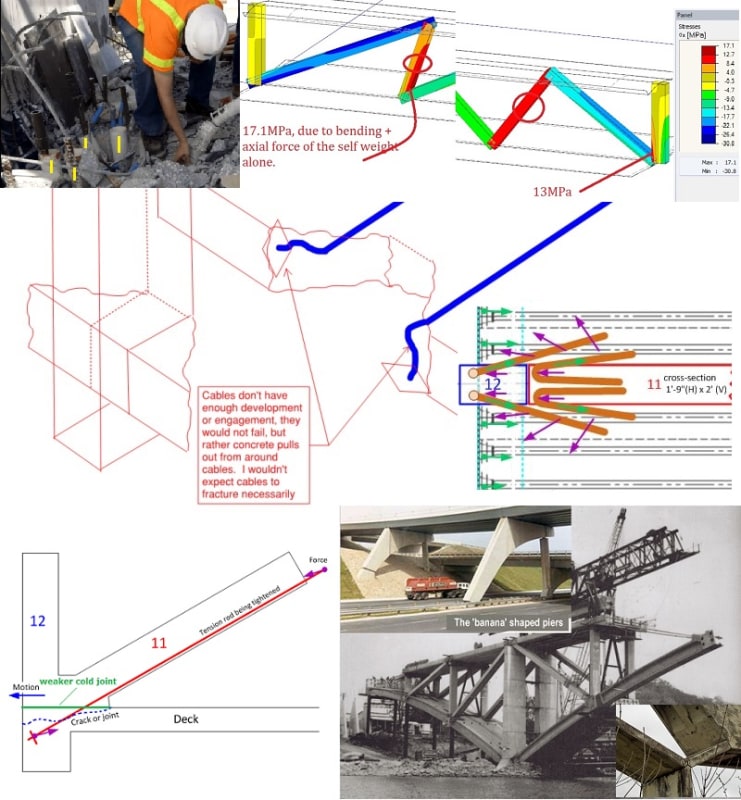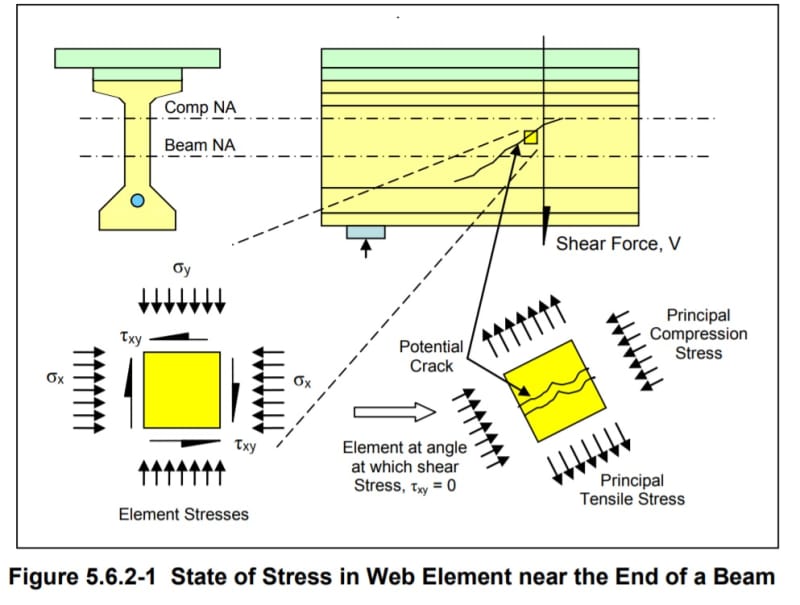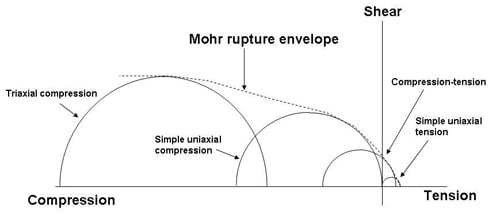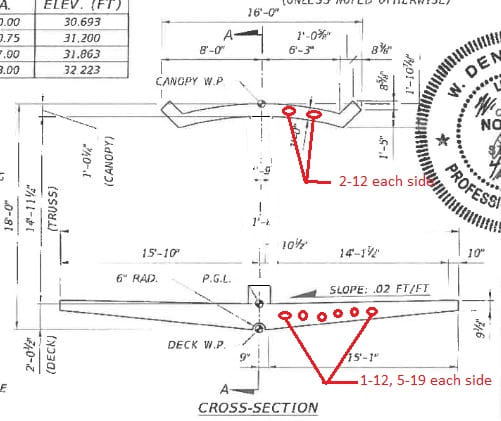Navigation
Install the app
How to install the app on iOS
Follow along with the video below to see how to install our site as a web app on your home screen.
Note: This feature may not be available in some browsers.
More options
Style variation
-
Congratulations cowski on being selected by the Eng-Tips community for having the most helpful posts in the forums last week. Way to Go!
You are using an out of date browser. It may not display this or other websites correctly.
You should upgrade or use an alternative browser.
You should upgrade or use an alternative browser.
Miami Pedestrian Bridge, Part VI 31
- Thread starter hokie66
- Start date
- Status
- Not open for further replies.
TheGreenLama
Structural
SFCharlie: In any analysis you also need to account for post-tensioning forces, anchorage forces, creep, shrinkage, and temperature forces over time. Not sure if anyone has included these in earlier attempts. As has been stated many times before, this is a complex concrete frame, not a steel truss.
Thank you Charlie, for bringing that back to my attention. It deserved a more detailed look. I did not discover the loads diagram on my first pass through the graphic. Lots to take in, there. Gotta zoom/pan around and around to take it all in. Not sure why it was presented that way.
"in it there's a link to the full analysis?"
Still can't find links to analysis, though. Just the pictures.
STF
"in it there's a link to the full analysis?"
Still can't find links to analysis, though. Just the pictures.
STF
chris snyder
Electrical
What's missing in the Toomas analysis are loads - I didn't ask him what numbers he used (he'd asked if I had centerlines at one point, but he soon sent the analysis), but may get back to him after I triple check mine (using new specs).
My question is why the stress is much different for #1/#2 and #11/#12 - is from asymmetric truss pattern, because #12 hangs off the deck, both, or ???. But he'd said 2D analysis wouldn't show this, and he's right - #1/#2 diag force shows ~40% higher than #11/#12 (they beefed up #1/2 but not #11/12). In final configuration, #1/2 would be floating on bearing pads (for expansion), while the pylon ends of main/backspans would be fixed, with some strengthening by being tied together and help from stabilizing pipes (but not as much as if this was a true suspension bridge).
Would be good to analyze the strength of the #11/#12/deck connection (is simpler) - even within 10%. Estimated diagonal force is ~1350-1500 kips plus 560 kips PT tension (totals ~1400 kips horizontal) - the rebar is in the specs. This area has weak boundaries with the ~3" PVC pipes (two on each side of #12), rebar/other rods (which strengthens concrete, but would seem to create a "parallel sheer plane?", e.g. if many spaced 2" apart parallel to sheer force), and the ~8"/large drain pipe at the bottom through the diaphragm - plus the cold joint itself, which photos show had cracked. The #4 photo showed another hole near #11 in deck (that was later filled?).
Someone asked what may have happened to the rebar cage under #11/12. That's a good question (in the canal?) because the concrete was pulverized at the base of #11/#12 members, but may have held within the "cage". A chunk is missing from deck (seen in photo), but deck held the lower #11 PT rod. Photo shows the deck concrete broke apart at the east side of vertical PVC pipes as #11/#12 sheered.
Interesting how hpaircraft's idea above (9 May 01:08) is similar to gwideman IV 24 Mar 18 13:55. I can't find good photos that show if the #1/2/deck area had PVC pipes, etc.
I've noticed in a few concrete truss bridges (very limited knowledge) that the connections aren't rigid concrete - hinges, pivots, and steel were used (two of these expected soil shifting). The FIU span was only concrete and rebar - cracks showed after tensioning (adding 560 kips?) with support only on ends even before it was moved. As independent engineers noted, the connection should have been analyzed instead of just saying it 'looked okay', moving the span, and working over traffic. I'm curious how cracks changed after it was moved.

My question is why the stress is much different for #1/#2 and #11/#12 - is from asymmetric truss pattern, because #12 hangs off the deck, both, or ???. But he'd said 2D analysis wouldn't show this, and he's right - #1/#2 diag force shows ~40% higher than #11/#12 (they beefed up #1/2 but not #11/12). In final configuration, #1/2 would be floating on bearing pads (for expansion), while the pylon ends of main/backspans would be fixed, with some strengthening by being tied together and help from stabilizing pipes (but not as much as if this was a true suspension bridge).
Would be good to analyze the strength of the #11/#12/deck connection (is simpler) - even within 10%. Estimated diagonal force is ~1350-1500 kips plus 560 kips PT tension (totals ~1400 kips horizontal) - the rebar is in the specs. This area has weak boundaries with the ~3" PVC pipes (two on each side of #12), rebar/other rods (which strengthens concrete, but would seem to create a "parallel sheer plane?", e.g. if many spaced 2" apart parallel to sheer force), and the ~8"/large drain pipe at the bottom through the diaphragm - plus the cold joint itself, which photos show had cracked. The #4 photo showed another hole near #11 in deck (that was later filled?).
Someone asked what may have happened to the rebar cage under #11/12. That's a good question (in the canal?) because the concrete was pulverized at the base of #11/#12 members, but may have held within the "cage". A chunk is missing from deck (seen in photo), but deck held the lower #11 PT rod. Photo shows the deck concrete broke apart at the east side of vertical PVC pipes as #11/#12 sheered.
Interesting how hpaircraft's idea above (9 May 01:08) is similar to gwideman IV 24 Mar 18 13:55. I can't find good photos that show if the #1/2/deck area had PVC pipes, etc.
I've noticed in a few concrete truss bridges (very limited knowledge) that the connections aren't rigid concrete - hinges, pivots, and steel were used (two of these expected soil shifting). The FIU span was only concrete and rebar - cracks showed after tensioning (adding 560 kips?) with support only on ends even before it was moved. As independent engineers noted, the connection should have been analyzed instead of just saying it 'looked okay', moving the span, and working over traffic. I'm curious how cracks changed after it was moved.

I do not think complete analysis are needed to pinpoint the problem with this structure, but could be done using available information.
AASHTO Guideline for the design of Pedestrian Bridges was used, supplemented by AASHTO LRFD for Bridges. Applicable load combinations were posted before, the only unknown is if Strength V was used as this is required only for major bridges. So, the bridge had likely SF=1.5 at the time of collapse, or less.
Judging on the location and magnitude of the crack at the base of #11, and the fact that the span was still fully supported, the crack was caused by post-tensioning and shrinkage alone.
So, the sequence of the post-tensioning is critical in establishing the magnitude of the forces generated in the nodes.
AASHTO and AREMA do not have explicit requirements for triaxial stresses, and how to handle sizing of the reinforcement for shear and tension in the areas where such 3-D loading occurs.
As I posted before, the bridge was a failure at the design stage, as nobody question the overall safety factor, and the design of the connections, which were dramatically weak for shear.
It is also worth noticing that the crack presented in the "accidentally" leaked photograph extend horizontally at the intersection of #11 and the deck, clearly indicating shear failure of concrete in between this two elements.
AASHTO Guideline for the design of Pedestrian Bridges was used, supplemented by AASHTO LRFD for Bridges. Applicable load combinations were posted before, the only unknown is if Strength V was used as this is required only for major bridges. So, the bridge had likely SF=1.5 at the time of collapse, or less.
Judging on the location and magnitude of the crack at the base of #11, and the fact that the span was still fully supported, the crack was caused by post-tensioning and shrinkage alone.
So, the sequence of the post-tensioning is critical in establishing the magnitude of the forces generated in the nodes.
AASHTO and AREMA do not have explicit requirements for triaxial stresses, and how to handle sizing of the reinforcement for shear and tension in the areas where such 3-D loading occurs.
As I posted before, the bridge was a failure at the design stage, as nobody question the overall safety factor, and the design of the connections, which were dramatically weak for shear.
It is also worth noticing that the crack presented in the "accidentally" leaked photograph extend horizontally at the intersection of #11 and the deck, clearly indicating shear failure of concrete in between this two elements.
Retiredat46
Member
FWIW, Have you seen this video published May 12 by Construction Engineering & Photography?
There are some screen shots from this thread in the video.
There are some screen shots from this thread in the video.
Great video... just a couple of comments:
The crane couldn't have been in a worse location; it obscures the initiation of the failure.
The second comment of maybe a little more merit. He places a fair amount of emphasis in the break in the canopy to the LHS of the intersection of Member 11 and the canopy. It appeared that way, and the reason I hadn't sorted out my reason for the collapse was that this is a lightly loaded member and the crack shouldn't have occurred there. In an ideal pin connected truss, it would normally be assumed to be a zero force member. I saw the 'crack' but couldn't explain it unless it was a consequence of the node (blister) failing. I still haven't 'wrapped my ears' around this. His explanation of the 'hinge' was well done... just in looking at the failure mechanism, it appears to be a hinge, and if any construction joint was beneath the support, it would likely have created this hinge. I still think the failureoccurred at initiated with the node, and, not at Member 11.
Dik
The crane couldn't have been in a worse location; it obscures the initiation of the failure.
The second comment of maybe a little more merit. He places a fair amount of emphasis in the break in the canopy to the LHS of the intersection of Member 11 and the canopy. It appeared that way, and the reason I hadn't sorted out my reason for the collapse was that this is a lightly loaded member and the crack shouldn't have occurred there. In an ideal pin connected truss, it would normally be assumed to be a zero force member. I saw the 'crack' but couldn't explain it unless it was a consequence of the node (blister) failing. I still haven't 'wrapped my ears' around this. His explanation of the 'hinge' was well done... just in looking at the failure mechanism, it appears to be a hinge, and if any construction joint was beneath the support, it would likely have created this hinge. I still think the failure
Dik
The Mad Spaniard
Structural
For dik and Retiredat46
At this moment I have turn my sight to the node 10-11-canopy. If you notice, the potential failure area above the struts and below the canopy is about 21x58 inches (1218 square inches). If you use the self weight values in the struts from Mr. Toomas Kaljas (with angles of 27.4 and 51.7 degrees), you get a 1700 kip horizontal interface force applied at the bottom face of the canopy. If we use the AASHTO section 5.8.4.3 coefficients for surfaces not intentionally roughened (K2 = 0.8) , it results in a maximum interface shear friction resistance of 1218x0.8=974 kips. If we reduce it by 0.9 we get 877 kips with is much less than 1700 kips (unfactored).
Now, I know that there are threedimensional effects that may change Mr. Kaljas forces if Mr. Kaljas model is aplane frame. Also the PT may produce forces contrary to the DL shearing load. But, this item is interesting.
Again, has anybody found in the drawings a note that says to roughen the surface to 0.25 inches? Because following the FDOT standard Specicications I believe you only clean the laitance and therefore you get K2=0.8.
With the limited info at this moment, I can not say more. I would appreciate if anybody out there check my analysis. Thanks in advance.
Good hunting.
Live long and prosper
At this moment I have turn my sight to the node 10-11-canopy. If you notice, the potential failure area above the struts and below the canopy is about 21x58 inches (1218 square inches). If you use the self weight values in the struts from Mr. Toomas Kaljas (with angles of 27.4 and 51.7 degrees), you get a 1700 kip horizontal interface force applied at the bottom face of the canopy. If we use the AASHTO section 5.8.4.3 coefficients for surfaces not intentionally roughened (K2 = 0.8) , it results in a maximum interface shear friction resistance of 1218x0.8=974 kips. If we reduce it by 0.9 we get 877 kips with is much less than 1700 kips (unfactored).
Now, I know that there are threedimensional effects that may change Mr. Kaljas forces if Mr. Kaljas model is aplane frame. Also the PT may produce forces contrary to the DL shearing load. But, this item is interesting.
Again, has anybody found in the drawings a note that says to roughen the surface to 0.25 inches? Because following the FDOT standard Specicications I believe you only clean the laitance and therefore you get K2=0.8.
With the limited info at this moment, I can not say more. I would appreciate if anybody out there check my analysis. Thanks in advance.
Good hunting.
Live long and prosper
Too soon to do any serious calcs, but, having a roughness of 1/4" would likely mean that you would have a 'hold down' force of approx the sum of the horiz components in Mem 10 and 11 x roughly sqrt(2) assuming a rough 45 degree plane. The vertical load would be small, so, friction could be roughly ignored. What may have been missed is that the horizontal connection would be the summation of the web diagonal horizontal loads because one is in tension and the other in compression... don't know yet.
Dik
Dik
TheSpaniard: Have you located tablular data that shows the type of loading, and member axial, shear and moment forces for Members 10, 11, 12, and the canopy RHS and LHS of member 10 and 11 intersection. I've looked through the postings and have been unable to locate this. Apparently, it was posted.
Dik
Dik
-
1
- #211
LRFD called out in plans:
Article 5.7.5 bearing spec called out in plans:
PT bar lift off test called out in plans:
Sheet B-24 Note 4:
...(CJ)...ROUGHENED...1/4"
Article 5.7.5 bearing spec called out in plans:
PT bar lift off test called out in plans:
Sheet B-24 Note 4:
...(CJ)...ROUGHENED...1/4"
Retiredat46
Member
I think sheet B-24 Note 4 only applies to the back span side of the pylon base. Since the forms for the truss on the main span were in place before the deck was poured, it would have been difficult to control or roughen the surface at the joint locations. Also, I couldn't find a similar note for those areas, but maybe I missed it.
Retiredat46 said:"Note 4 only applies to the back span side of the pylon base"
I don't think you missed similar notes, no one else has found any. I mentioned B-24 note just to hint that no call out for roughing exists elsewhere for superstructure.
I linked to a LRFD document in my last post as it helped me get into the mindset of the designers of this overpass, and I feel others may share this sentiment.
This thread as concentrated on the span being a concrete truss, and of course it is, however, it is also a bulb I-beam or girder with an open web. As such I believe the following diagram to be enlightening. This thinking may be wrong, but if you go with it, it makes some sense out of what happened to bridge. (In my experience mechanical engineers often simplify the parameters of a problem and then take it the extreme when analysing, similar to Occam's razor.
US Department of Transportation Publication No. FHWA-NHI-15-047 5.105

Any comments on this diagram?

The Mad Spaniard
Structural
Thanks dik, retiredadat46 and jr87 for the responses.
The 1/4" roughness may be an important omission in the plans. But we have to remember that the plans have a date of 4/7/17. There may be another more recent set with revisions or the inspectors asked the question and there is a memo requesting to roughen the joints. We have to wait to get more info from FIU via the Miami Herald.
And responding to dik question, I haven't seen any open posted or published mumbers other that Mr. Kaljas numbers above in this thread or what is in the plans. I have not done a structural analysis of the system. I will try to send an e-mail to Mr. Kaljas to see in he can implement the PT in his model and share the info will all of us.
Best regards
The 1/4" roughness may be an important omission in the plans. But we have to remember that the plans have a date of 4/7/17. There may be another more recent set with revisions or the inspectors asked the question and there is a memo requesting to roughen the joints. We have to wait to get more info from FIU via the Miami Herald.
And responding to dik question, I haven't seen any open posted or published mumbers other that Mr. Kaljas numbers above in this thread or what is in the plans. I have not done a structural analysis of the system. I will try to send an e-mail to Mr. Kaljas to see in he can implement the PT in his model and share the info will all of us.
Best regards
TheGreenLama
Structural
Generally, post-tensioned spans have a solid web whereby the c.g. of the PT force can move up and down depending on the loading and support conditions. An I-beam or a concrete box girder are common examples. In our instance we have neither (I've removed web from drawing):

All PT is straight and located outside the centerline of the bridge. And as far a "web" goes, we don't have an open web, we have no web. Particularly in the end regions of the bridge, how is the PT developed across the cross-section? What is the cross-section? So not only are there issues with shear lag at the supports--all PT is located outside the centerline of the bridge, but there's no web tieing the flanges together. And why is there even PT in the top canopy at this stage? If it's a "truss" you wouldn't expect the need. Is it there to partially balance the bottom (rough calcs show PT stress in top canopy roughly 50% that of bottom slab)? Is it there to help in some way with shear? Is it needed because there's bending in the top canopy?
I'm still not clear exactly how this bridge behaves, other than to call it an ill-conceived frame.

All PT is straight and located outside the centerline of the bridge. And as far a "web" goes, we don't have an open web, we have no web. Particularly in the end regions of the bridge, how is the PT developed across the cross-section? What is the cross-section? So not only are there issues with shear lag at the supports--all PT is located outside the centerline of the bridge, but there's no web tieing the flanges together. And why is there even PT in the top canopy at this stage? If it's a "truss" you wouldn't expect the need. Is it there to partially balance the bottom (rough calcs show PT stress in top canopy roughly 50% that of bottom slab)? Is it there to help in some way with shear? Is it needed because there's bending in the top canopy?
I'm still not clear exactly how this bridge behaves, other than to call it an ill-conceived frame.
TheGreenLama - In the original proposal, the only portion of the bridge that was to be post tensioned prior to the move was the deck. At least that is my take. The repositioning of the SPMTs seems to have resulted in a lot of addition PT decisions.
Surface Prep:
Here is one concrete surface note I came across from the Deck Pour drawing.


Surface Prep:
Here is one concrete surface note I came across from the Deck Pour drawing.


TheGreenLama
Structural
epoxybot, so it's conceivable that some portion of top PT is required for the temporary load conditions during the move.
TheGreenLama said:"...we have no web."
TheGreenLama, very well put, I see your point. It seems also a whole section of engineering discipline was missing in this project.
TheGreenLama - Assuming PT Rod became necessary in members #2 & #11, as a result of new locations of the SPMT (Cantilever Condition), yes. Stress the deck, stress the canopy, stress #2 & #11 ...,
If the canopy isn't stressed before #2 & #11 are stressed, wouldn't the canopy crack somewhere between the 2/3 & or 10/11 blisters?
If the canopy isn't stressed before #2 & #11 are stressed, wouldn't the canopy crack somewhere between the 2/3 & or 10/11 blisters?
- Status
- Not open for further replies.
Similar threads
- Question
- Replies
- 27
- Views
- 24K
- Replies
- 1
- Views
- 5K
- Replies
- 13
- Views
- 13K
- Replies
- 6
- Views
- 3K
- Replies
- 17
- Views
- 11K
